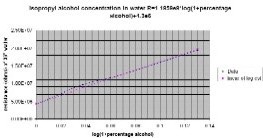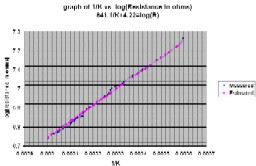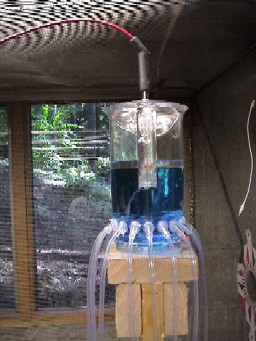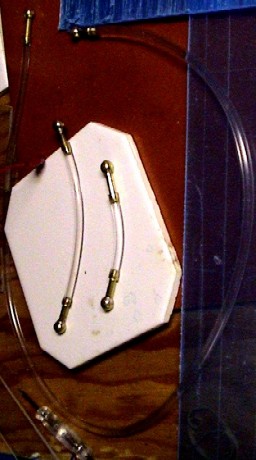
a water/alcohol/dye mix resistor undergoing thermal runaway. |

Graph of resistance v.s. Alcohol level at constant temp. |

Graph of resistance v.s. Temperature straight tap water (no alcohol). |

Resistor manifold for 16 x 8megohm current limiting resistors, 1 gal distilled
water with 1/8th teasp. salt and tons of red food coloring, 1/8"i.d. pvc tube of about 6' lengths were used,
note oil on top of the water's surface. |

Resistor manifold for 16 x 8megohm current limiting resistors, 1 gal distilled
water with 1/8th teasp. salt and tons of blue food coloring, 1/8"i.d. pvc tube of about 6' lengths were used,
note oil on top of the water's surface. |
Some background. I needed 48, 9 megohm 22watt 16kv resistors. I priced the
soldering together a buncha resistors and putting them in oil, too many solder
connections and the price of the resistors was upwards of $200. To get 48 single HV
resistor (of the wattage/voltage) was even more. I read a bit of history on
old timers who used water for a resistor and saw some webpages where others had
done this.
Water was out of our tap (its almost the right concentration of 'stuff') The
alcohol was added to help control algae problems I've been noticeing over the
last few weeks.
all values are for a 36" pvc tube with a 1/8" i.d. At 80 degrees water
temperature I see a linear slope with the log of (1+percentage of alcohol to
water) 0%, 4.3Mohms; 9%, 9.6Mohms; 17%, 12.4 Mohms, 35% 19.5Mohms; 70%
unmeasureable even when cutting the length down to 1.75"
practical problems were the 35% solution had to be chopped to 4.25" to measure
anything, then the results scaled back up to the 36" length.
As Myrl predicted there was quite a bit of temperature dependance, (more than I
though for sure, I did expect some...) there was even more temp dependance for
the 35% isopropyl soln.
a 36" tap water (0% alcohol) went from a resistance of 7.5Mohms at 60F to 2.45Mohms at 145F
the 4.25" (35% alcohol) water went from a resistance of 8+Mohms at 60F to 2.2Mohms at 145F
(some of this could be my impatience for the temp to stabilize in the 36")
Strange note, 10kvac through a 1.75" (70% alcohol) gets the 'resistor' really
warm, although the dc resistance after disconnect but while still hot is still
off the 20Mohm scale, could this be 'surface effect' on the pvc tubing itself?
I'm already tied to using probably 6' runs of tubing for mechanical connector
reasons, so if I do want to use alcohol I'll probably have to dope the
water/alcohol a bit more.
There were many issues with using isopropyl/water solutions, wacky resistance
fluctuations and increased temperature dependance. I'm probably just going to
use straight water doped a bit with a food dye and burn in the resistors to
kill any algae which might try and get in, then I'll just make sure I can change
the water easily when it gets too scuzzy.
When a water/alcohol/dye mix undergoes thermal runaway, it makes outgassing
noises and the bubble gets really really big, it's almost like a thermal
crowbar. any liquid that tries to bridge the bubble is a thin trickle and
immediately gets gassed destroying itself so its a steady near zero current
situation.



